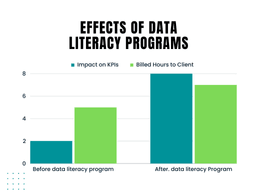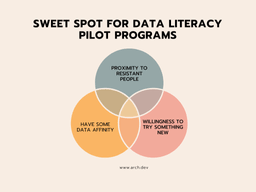Dan is a data consultant working with a medium-sized business, helping the client set up a data stack and building a default set of reports and dashboards. The work is well-paid, and the client seems happy.
After finishing the initial setup and the reports, Dan is ready for the next step: to help get the client to the next level to put the data to use. He plans on educating the client about data, in a word, data literacy.
But, as he discusses his plan with the Head of Marketing, who hired him to set up the reports and dashboards, the client flat-out refuses. He’s happy with the numbers; he doesn’t think he needs more, and he’s OK with how his decisions play out.
The data literacy resistance
Sounds familiar? That’s resistance! The data literacy resistance.
It happens to all data consultants and comes in various forms and directions.
Everyone is reluctant to change, as are your clients. Helping them become more data-inspired is a fight against resistance, and you need to handle it as such.
Don’t expect to win your client over with logical arguments; companies have complex dynamics, and you need to have an excellent strategy to tackle the resistance inside them.
Logic isn’t going to help with human resistance.
But to grow your business with a client, you’ll also need to let the client’s data literacy grow! So, Dan is facing a severe dilemma. How can he overcome this resistance?
We have a suggested approach that you can adapt to meet your specific situation and client. It’s a simple three-step process.
- Identify resistance points: By using a workshop
- Find a vantage point: By doing a data literacy assessment
- Get the first stone rolling: By launching a pilot education program
Once you go through these three steps, you’ll likely have reduced the resistance enough to provide a data literacy program to your client and scale your project with him!
Step 1: Identify resistance points
Almost always, the resistance you see is indirect. Dan might see resistance from the Head of Marketing, but it might be the marketing managers inside the department who don’t put much value into truly resistant data.
It might also be the CEO trying to keep the project down.
If the manager who pays for you seems reluctant, more often than not, it’s his colleagues or boss who indeed resist putting data to more use inside the company.
So, propose a workshop to get everyone into one room. We know those are hard to organize because they take a lot of time from the client, but they are usually worth it if you do them right.
The genius of a workshop is that it can serve a two-fold goal:
- for you, the workshop’s goal is to help you identify resistance points
- for the client to understand the potential that data could have inside his company.
I’ve run dozens of workshops with high-level decision-makers and managers, and they never are eager to spend much time in a lengthy workshop. What I’ve realized over the years is that two things help a lot:
- to keep it short, by using pre-workshop and post-workshop tasks,
- to keep it to the point by providing a clear goal and outline upfront.
Here’s what such a workshop could look like:
- Pre-Workshop (work for you!)
- Survey Participants – Send out a pre-meeting survey to gather initial thoughts on data education; don’t make it more than two questions! You want to engage them, not scare them.
- Review Historical Data Successes – Prepare 2 case studies from inside the same industry.
- Send around the outline and the time slot.
- During the Workshop
- (30 minutes) Storytelling Session – Share your two stories, but keep it short.
- (5 minutes) Ask participants to brainstorm more case studies they heard and liked.
- (5 minutes) Model – Then, share a common model connecting these stories. Any model will do; keep it simple.
- (5 minutes) Breakout Groups – Divide participants into small groups to brainstorm ways to improve how they use data internally AND potential problems (”resistance”) with that approach.
- (15 minutes) Let each group present their results and collect them. Let the group rank and identify 2 top ideas.
- Post-Workshop Action Steps (work for you!)
- Identify Key Resistance Themes: Summarize the main points of resistance identified during the workshop; also, note which group proposed them. Watch out for key decision-makers and departments.
This way, you get happy workshop participants who walk away with good ideas, and you get to identify what the company as a whole identifies as problematic points.
Step 2: Find a vantage point
I like to do workshops first because they get people moving, and they have a concrete goal and a concrete outcome. They are a great way to kick off things.
Once you’ve got people interested, you can take a minute to really assess their data literacy levels by using any assessment you have at hand.
Again, remember you’re doing this to overcome resistance to selling a data literacy program, so we suggest you keep it short. There’s no shame in using predefined templates if you can adapt them to your client quickly.
Here’s a good example questionnaire consisting of just ten questions designed by the data literacy project:
If you want to develop your own assessment, you can look into the guide provided by Atlan, the company behind one major data catalog.
Once you’ve run the data literacy assessment, you can combine your results from the workshop and the assessment and find a set of pilot people that:
- are close to significant resistance points (like the assistant to the Head of Marketing for Dan)
- are willing to be educated (look for junior people or people who pitched in a lot during the workshop)
- are not entirely new to data (use the data assessment to judge that)
Step 3: Get the first stone rolling
Once you’ve identified good points to start to remove the resistance, a set of people somewhat willing to be educated, it’s your time to move.
Propose a short-term, low-risk pilot data education program targeting a specific department or team, highlighting its potential impact on their daily tasks and overall business objectives.
Make sure you:
- Incorporate Feedback Mechanisms – Include surveys and feedback sessions within the pilot program to address concerns, adapt the training, and improve engagement. These are 10 times more important than in other programs because you’ll need to justify rolling out a larger program.
- Set Clear Objectives – Define what the program aims to achieve, linking these goals to daily tasks and broader business objectives. An example could be “every participant should be able to base 2 of his daily decisions on data” or more technical goals like “every participant should be able to answer the following three questions using Looker”
- Develop the Curriculum – Create content directly relevant to the participants, incorporating real-world data and scenarios from their work environment.
- Pilot Launch: Roll out the program with a small group to test its effectiveness and adjust as necessary.
Moving on
Once you’ve completed your pilot program, you should have everything in hand to continue growing your clients’ data adoption. Propose a larger rollout of the data literacy program and start to sell additional data-related services.
To keep your momentum going, keep your feedback sessions up, and celebrate all of the program’s participants regularly publically, say with a monthly email.


